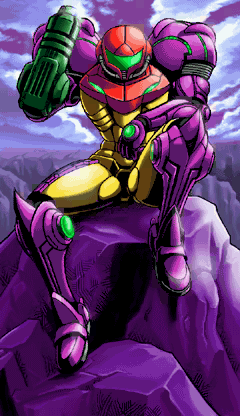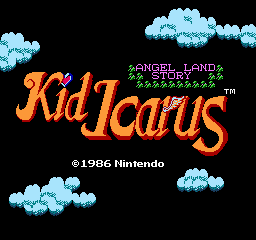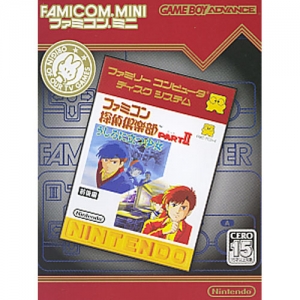Special articles, columns and features exclusive to the MDb.
Famicom Disk System:
The More You Play It, the More You'll Want to Play! [Disk 2]
Introduction | Part 1 | Part 2 | Part 3 | Part 4 | Part 5 | Part 6 | Part 7 | Part 8
WE WANT TO EXPERIENCE GOOD RELATIONSHIPS BETWEEN DEVELOPERS AND PLAYERS, TOOWell, with the "Disk System Selection", the games everyone made have been resurrected, but does everyone have a message for all the players?Sakamoto: First, Metroid... (turning to Kiyotake-san) What do you think? Kiyotake: Well, let's see. It might not be as palatable for the people who have grown accustomed to the gentle games made now! (Laughs) However, they say they want to play a game that feels "like the old Metroid." Sakamoto: Although we put the American version of Metroid into Metroid Zero Mission, people today might think it's a little difficult. Of course, lots of people want to play it, but... Osawa: Now hold on, you haven't said anything that will contribute to the sales of the Famicom Mini! (Laughs) Sakamoto: That's what we're doing! (Laughs) (In a very cheerful tone) Even today, Metroid is a game that should be called a masterpiece! Everyone: (Laughs heartily) Osawa: And while you're at it, please buy Zero Mission too, as the Metroid remake will certainly make you just as happy! (Laughs) Sakamoto: That's a great comment! (Laughs) |

Zero Mission was just released on May 27. New areas have been added, and the game has been drastically upgraded. |
(Laughs) What about Kid Icarus?Osawa: Although it's my debut work, how should I put it, since it feels like looking at my high school yearbook, I think I'd like to answer that. I want to try and reaffirm that was my style in those days, and please understand that everyone was making games in that style 18 years ago. I think the relentlessness of those games was the style of that era, too. Sakamoto: You have to understand Kid Icarus was made in the style of that era. Customers were also perfectly willing to play it, and we were perfectly willing to make it that way. If we made it challenging in that they were "difficult to understand", and if players who accepted it said, "I figured it out. SOLVED IT~!" we had a very good relationship with them. If people felt they could do that sort of thing now, it would be very interesting. Osawa: In those days, the atmosphere was like the creators and players competing against each other. Both wanted to get the other to lose. However, most recently, I feel designers have to be more careful to appeal to players - well, in a positive way; although I think we have to do it that way. In those days, it seems creators and players grew up together.Sakamoto: That's right. Because we were making things together that neither of of us had played before. Osawa: The result was people raised on the Famicom became game magazine editors, and people who can say "We played those in grade school," have entered Nintendo and are making games. In that way, it's a good thing that games people grew up playing back then can be easily played now on the Famicom Mini. However, I think when they play with the Famicom Mini, they might wonder, "Why won't the game start when I press the A Button?" Sakamoto: Huh, why won't the cursor move up and down when I press the D-Pad? (Laughs) Osawa: "What, I have to press the Select Button over and over again to do it?" These days, people would become discouraged by that! (Laughs) Sakamoto: They'd wonder, "Isn't that a bug?" |

Toru Osawa was the designer of Kid Icarus. He designed most of the game by himself! See the previous issue for more info. |
(Laughs). Yamamoto-san, is there something you want to say about the sound screen?Yamamoto: In the Famicom era, there were only four sound channels. Under those restrictions, sound programmers struggled to make music. Because of that, since the Disk System added an FM sound source, even though it was a cheap environment, that's how we made the sounds we came up with. We would strain our ears and listen, and through that method, I think we could certainly hear it. As for the music of games of that era, since there wasn't much storage, we would repeat the same code patterns, and I think those phrases would remain in the ears. So I really hope people will enjoy listening to it. Sakamoto: Incidentally, the rating* of The Girl who Stands Behind is recommended for ages 15 and up. *Rating - System for checking the level of violence and crimes contained in a game's expressive contents, with the recommended age rating indicated on the package. These inspections are conducted by the game ethics inspection organization "CERO" (The Japanese equivalent of the ESRB. -Ed.). That's the first Nintendo software that wasn't listed as "targeted to all ages".Sakamoto: Yeah. There was a discussion where we said, "This is poorly presented," but if we changed it, the final product wouldn't have been Famitan, so I responded, "No, don't do that." Besides, it made sense to leave the game as it had been more than 10 years ago, and they released it without changing it. |

The Famicom Mini re-release of The Girl who Stands Behind was given a CERO rating of 15, equivalent to an M rating in the US. -Ed. |
What expressions did you get held up on?Sakamoto: There couldn't be anything at all that was grotesque or cruel. There was a scene where a guy was smoking cigarettes, and were held up on that, but since the stories he was telling was very warmhearted, you wouldn't want to think, "So he's the murderer." I see.Sakamoto: Beyond that, when you wanted to hear some advice in The Missing Heir, you shouldn't listen to the small legend from the "head priest". Osawa: Heh heh heh heh. (Smiles) Sakamoto: He told a long story, and he wouldn't tell you that's what he was going to do! (Laughs) He was especially formidable in Part One. Osawa: That's another point of regret from those days! (Laughs) Sakamoto: Listen to it at your own risk! (Laughs) He'd ask, "Is that right, you want to hear it?" And then the "back" option was redded out, and he talked nonstop! (Laughs) |

This is the dialogue box for the "Head Priest". (Laughs) The story is long and although it's ok to skip over it, it's an old game, so... |
Introduction | Part 1 | Part 2 | Part 3 | Part 4 | Part 5 | Part 6 | Part 7 | Part 8










